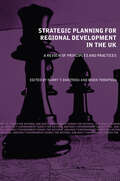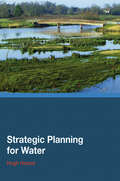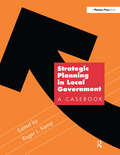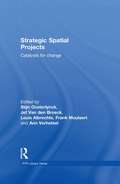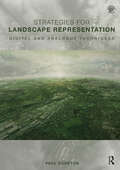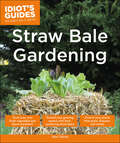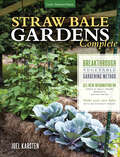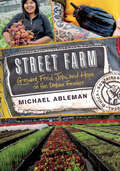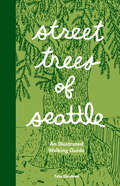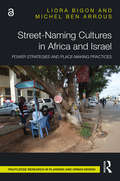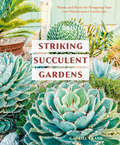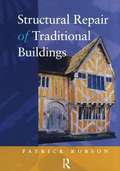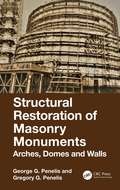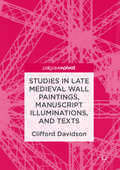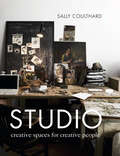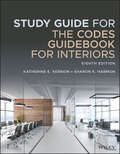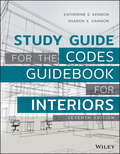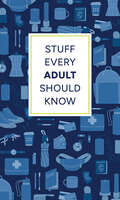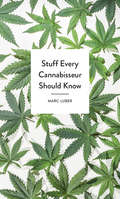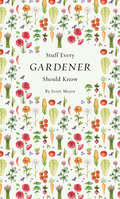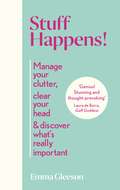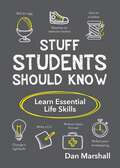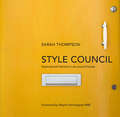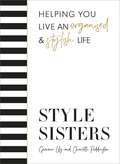- Table View
- List View
Strategic Planning for Regional Development in the UK (Natural and Built Environment Series)
by Harry T. Dimitriou Robin ThompsonWith contributions from leading academics and practitioners, Strategic Planning for Regional Development in the UK is the most up-to-date treatment of a fast-changing subject. The book discusses: The evolution of regional planning in the UK and the strategic thinking involved The spatial implications of regional economic development policies The methods and techniques needed for the implementation of strategic planning for regional development How strategic planning for regional development is currently put into practice in three UK regions with different priorities. Strategic Planning for Regional Development in the UK is essential reading for students and academics working within strategic and regional planning and provides policy makers and practitioners with a comprehensive and thought provoking introduction to this critically important emerging field.
Strategic Planning for Water
by Hugh HowesStrategic Planning for Water examines the neglected relationship between planning for water and spatial planning. It provides the background to sustainable water management and assistance to spatial planners in understanding the complex water environment. This extremely topical book examines the challenges of:how to ensure that water supplies are a
Strategic Planning in Local Government: A Casebook
by Roger KempThis book shows how and why strategic planning is working in cities around the country. It illustrates how this technique enables a city to plan its future proactively and shows how local governments use it to solve current problems and make sure they continue to reach their goals. Using seventeen case studies from a diverse mix of cities, it outli
Strategic Spatial Projects: Catalysts for Change (RTPI Library Series)
by Stijn Oosterlynck Louis Albrechts Frank Moulaert Jef Van Den Broeck Ann VerhetselStrategic Spatial Projects presents four years of case study research and theoretical discussions on strategic spatial projects in Europe and North America. It takes the position that planning is not well equipped to take on its current challenges if it is considered as only a regulatory and administrative activity. There is an urgent need to develop a mode of planning that aims to innovate in spatial as well as social terms. This timely, important book is for spatial planning, urban design and community development and policy studies courses. For academics, researchers and students in planning, urban design, urban studies, human and economic geography, public administration and policy studies.
Strategies for Landscape Representation: Digital and Analogue Techniques
by Paul CuretonStrategies for Landscape Representation discusses a variety of digital and analogue production techniques for the representation of landscape at multiple scales. Careful consideration is required to represent time, and to ensure accuracy of representation and evaluation in the landscape.Written as a guide for making appropriate selection of a wide variety of visualisation tools for students and built environment professionals with an interest in landscape, the book charts emerging technologies and historical contexts whilst also being relevant to landscape legislation such as Building Information Modelling (BIM) and Landscape Assessment. This book is an innovation-driven text that encourages readers to make connections between software, technology and analogue modes. The management, choice and combination of such modes can arguably narrow the unknown of landscape character, address the issues of representing time and change in landscape and engage and represent communities’ perceptions and experience of landscape.Showcasing international examples from landscape architecture, planning, urban design and architecture, artists, visualisers, geographers, scientists and model makers, the vitality of making and intrinsic value of representational work in these processes and sites is evidenced. An accompanying companion website provides access to original source files and tutorials totalling over a hundred hours in mapping and GIS, diagrams and notation, photomontage, 3D modelling and 3D printing.
Straw Bale Gardening (Idiot's Guides)
by John TullockGardening has "grown" to be more popular than ever. Idiot's Guides: Straw Bale Gardening features a great way to grow vegetables — even when space is limited. Hundreds of helpful, step-by-step color photographs illustrate how to arrange, prepare, and successfully grow a straw bale garden. Professional advice on what to grow and how to maximize yield is also included.
Straw Bale Gardens Complete: Breakthrough Vegetable Gardening Method
by Joel Karsten“Are you ready to learn about a transformative garden technology that could change your life—for less than $100?” —New York TimesTake your straw bale gardening to the next level—in more places, with new products, and even sometimes skipping the straw entirely—with Straw Bale Gardens Complete. The reception and enthusiasm for straw bale gardening, introduced in 2013, has proved revolutionary in vegetable growing. Why? Because the bold promises in the book are kept: grow vegetables anywhere, earlier in the year, with no weeding. Gardeners everywhere are excited. Straw bale gardening works! In just the short amount of time that has passed, the gardening world and Joel Karsten himself have learned even more about how to apply this method in just about any environment: on a city balcony, in a rocky outpost, in a desert, and even in the tundra of Alaska. Straw Bale Gardens Complete contains all of the original information that has set the gardening world on fire. But it also goes much deeper, with nearly fifty pages of all-new advice and photos on subjects such as growing in a tight urban setting, making your straw bale garden completely organic, and using new fertilizers and conditioning products. There is even information on using straw bale techniques to grow veggies in other organic media for anyone who has a hard time finding straw. Fans of Straw Bale Gardens will not want to miss adding Straw Bale Gardens Complete to their gardening library. There is, literally, nothing else like it!
Street Farm: Growing Food, Jobs, and Hope on the Urban Frontier
by Michael AblemanStreet Farm is the inspirational account of residents in the notorious Low Track in Vancouver, British Columbia—one of the worst urban slums in North America—who joined together to create an urban farm as a means of addressing the chronic problems in their neighborhood. It is a story of recovery, of land and food, of people, and of the power of farming and nourishing others as a way to heal our world and ourselves.During the past seven years, Sole Food Street Farms—now North America&’s largest urban farm project—has transformed acres of vacant and contaminated urban land into street farms that grow artisan-quality fruits and vegetables. By providing jobs, agricultural training, and inclusion in a community of farmers and food lovers, the Sole Food project has empowered dozens of individuals with limited resources who are managing addiction and chronic mental health problems.Sole Food&’s mission is to encourage small farms in every urban neighborhood so that good food can be accessible to all, and to do so in a manner that allows everyone to participate in the process. In Street Farm, author-photographer-farmer Michael Ableman chronicles the challenges, growth, and success of this groundbreaking project and presents compelling portraits of the neighborhood residents-turned-farmers whose lives have been touched by it. Throughout, he also weaves his philosophy and insights about food and farming, as well as the fundamentals that are the underpinnings of success for both rural farms and urban farms. Street Farm will inspire individuals and communities everywhere by providing a clear vision for combining innovative farming methods with concrete social goals, all of which aim to create healthier and more resilient communities.
Street Trees of Seattle: An Illustrated Walking Guide
by Taha EbrahimiThe majestic trees of Seattle's neighborhoods take center stage in this illustrated and informative walking guide. Want to discover which neighborhood has the highest concentration of cherry street trees when cherry blossoms are at their peak?Eager to stroll down the only street lined with western red cedars?Curious how monkey puzzle trees made their way to the city?Using data visualization as a starting point, the author takes readers on a tour of existing street trees throughout Seattle's neighborhoods and iconic parks through charming illustrations and maps. In the process, she educates readers on the history of the trees and the city, and offers up sketches of trees, leaves, and leaflets to identify trees throughout 33 different neighborhoods. The most notable of each species are highlighted, so urban adventurers can fully appreciate their surroundings or design their own walking routes to experience these natural wonders in their favorite areas of the city.The book is organized alphabetically by neighborhood and each area: Showcases a species of treeIncludes a history of the tree and neighborhoodOffers maps and callouts for spotting the best street specimens In an increasingly digital world, the book invites readers to slow down and embrace an analog approach to tree-spotting during their urban meanderings.
Street-Naming Cultures in Africa and Israel: Power Strategies and Place-Making Practices
by Liora Bigon Michel Ben ArrousThis book is focused on the street-naming politics, policies and practices that have been shaping and reshaping the semantic, textual and visual environments of urban Africa and Israel. Its chapters expand on prominent issues, such as the importance of extra-formal processes, naming reception and unofficial toponymies, naming decolonisation, place attachment, place-making and the materiality of street signage. By this, the book directly contributes to the mainstreaming of Africa’s toponymic cultures in recent critical place-names studies. Unconventionally and experimentally, comparative glimpses are made throughout between toponymic experiences of African and Israeli cities, exploring pioneering issues in the overwhelmingly Eurocentric research tradition. The latter tends to be concentrated on Europe and North America, to focus on nationalistic ideologies and regime change and to over-rely on top-down ‘mere’ mapping and street indexing. This volume is also unique in incorporating a rich and stimulating variety of visual evidence from a wide range of African and Israeli cities. The materiality of street signage signifies the profound and powerful connections between structured politics, current mundane practices, historical traditions and subaltern cultures. Street-Naming Cultures in Africa and Israel is an important contribution to urban studies, toponymic research and African studies for scholars and students. Chapters 1 and 2 of this book are freely available as a downloadable Open Access PDF under a Creative Commons Attribution-Non Commercial-No Derivatives 4.0 license available at http://www.taylorfrancis.com/books/e/9781003173762
Streets and Patterns: The Structure Of Urban Geometry
by Stephen MarshallThere is an emerging consensus that urban street layouts should be planned with greater attention to ‘placemaking’ and urban design quality, while maintaining the conventional transport functions of accessibility and connectivity. However, it is not always clear how this might be achieved: we still tend to have different sets of guidance for main road networks and for local streetgrids. What is needed is a framework that addresses both of these, plus main streets – that don’t easily fit either set of guidance – in an integrative manner. Streets and Patterns takes up this challenge to create a coherent rationale to underpin today’s streets-oriented urban design agenda. Informed by recent research, the book looks behind existing design conventions and beyond immediate policy rhetoric, and analyses a range of first principles – from Le Corbusier and Colin Buchanan to New Urbanism. The book provides a new framework for the design and planning of urban layouts, integrating transport issues such as road hierarchy, arterial streets and multi-modal networks with urban design and planning issues such as street type, grid type, mixed-use blocks and urban design coding.
Striking Succulent Gardens: Plants and Plans for Designing Your Low-Maintenance Landscape [A Gardening Book]
by Gabriel FrankDesign a succulent garden of your own, with inspiration, advice, and instructional step-by-step projects for container gardens, small-space gardens, mixed gardens, and more.You can't help but be mesmerized by the eye-catching geometric forms and jewel-toned colors of succulents. But how do you grow these beauties in your own garden? One of the only books dedicated to succulent garden design, Striking Succulent Gardens is a stylish, modern gardening book for beginners and enthusiasts alike.Known for his colorful approach and bold use of varied textures and shapes, garden designer Gabriel Frank offers practical ideas, simple concepts, stunning full-color photography, step-by-step instructions for a dozen different gardens, plant recommendations, basic succulent care, and an inspired approach to creating living art in your own garden. For those in colder climates, there is a list of cold-hardy succulents and advice for bringing container gardens indoors for the winter, making succulent gardens achievable no matter where you live.Tough, water-wise, wildly popular, and nearly indestructible, succulents will transform your outdoor space, providing gardens of every size with minimal maintenance and maximum impact.
Structural Repair of Traditional Buildings
by Peb RobsonThis book will be of interest to everyone involved in the repair, maintenance and refurbishment of traditional buildings. Its purpose is to promote the successful structural repair of masonry, timber and unfired earth. The book begins by explaining how traditional structures work and how they are affected by the behaviour of the soil that supports them. It goes on to explain how the structural design of buildings has to cope with uncertainty. Techniques for doing so are well established for new buildings, but the viewpoint changes when existing buildings need to be repaired or refurbished. The most common sources of structural damage are listed. The more serious and progressive ones are described in detail, as an aid to diagnosis and prognosis. An understanding of prognosis enables repairers to decide whether urgent intervention is necessary or whether the problem can be allowed to run its course. A straightforward method is proposed for arriving at the most suitable remedy. Several typical repairs are illustrated. The book covers many allied topics, including the principles of conservation, health and safety and preventative maintenance. A chapter is devoted to the special needs of insured perils.
Structural Restoration of Masonry Monuments: Arches, Domes and Walls
by George G. Penelis Gregory G. PenelisHistoric structures need to be restored in line with international guidance and charters developed by architects and archaeologists, but technical understanding of structural engineering and materials is crucial, particularly with respect to response to earthquake loading. This guide to structural assessment and restoration of masonry monuments and historical buildings outlines the techniques, materials and design procedures used. It begins with principles, theory and practice and then presents case studies. The assessment focusses on Building materials and construction techniques used in the past The mechanics of masonry The structural behaviour of masonry monuments and historical buildings In-situ investigation and laboratory tests for existing and restoration materials. The restoration elaborates on Techniques and materials available for structural restoration Structural analysis and design Deciding on the restoration scheme Emergency measures and protective measures.
Studies in Late Medieval Wall Paintings, Manuscript Illuminations, and Texts
by Clifford DavidsonThis volume is an interdisciplinary consideration of late medieval art and texts, falling into two parts: first, the iconography and context of the great Doom wall painting over the tower arch at Holy Trinity Church, Coventry, and second, Carthusian studies treating fragmentary wall paintings in the Carthusian monastery near Coventry; the devotional images in the Carthusian Miscellany; and meditation for "simple souls" in the Carthusian Nicholas Love's Mirror of the Blessed Life of Jesus Christ. Emphasis is on such aspects as memory, participative theology, devotional images, meditative practice, and techniques of constructing patterns of sacred imagery.
Studio: Creative Spaces for Creative People
by Sally CoulthardDiscover what kind of stunning spaces for creative work you can build in your own home no matter your budget with this inspirational DIY guide.Art, craft and all things homemade have never been more popular and the trend for working from home continues apace. But it can be tricky to carve out a space in your house that lets you indulge your passion or earn a living from your creativity. Studio and study spaces are special places—full of creative spirit and practical potential—and there’s never been a greater demand for a book that shows you how to carve out a corner that allows you to not only practice your craft, but inspires and facilitates the very work you create.Real-life case studies from seven different countries, ranging from crafters, writers, designers and artists, show readers just what can be achieved on every budget. Many of the studio owners featured have a dedicated and ever-expanding social media following, including fashion designers Kiel James Patrick and Sarah Vickers, woodworker Ariele Alasko, designer Sarah Sherman Samuel, fine artist Lisa Congdon and decor blogger Holly Becker.Detailed chapters outline the vital pieces needed to create a functioning and inspirational studio space, while also taking an in-depth look into different styles of studios for craft and creative activities. With Studio, Sally Coulthard shows you that spaces for creativity can be easy to make, look beautiful, and fitted into any home.Praise for Studio“A visual feast of a sourcebook . . . features real-life home offices to inspire even the most spatially challenged of us.” —Fabric magazine“A fantastic and inspiring volume.” —Holly Becker“A lovely peek into lots of different creative studios, from potters to knitters, textile designers to fine artist, and every one is a delight.” —The Women’s Room“Working from home has never been so stylish.” —Ham & High
Study Guide for The Codes Guidebook for Interiors
by Katherine E. Kennon Sharon K. HarmonSTUDY GUIDE FOR THE CODES GUIDEBOOK FOR INTERIORS The comprehensive study guide for understanding interior codes This revised and updated eighth edition of the Study Guide for the Codes Guidebook for Interiors is an essential companion to The Codes Guidebook for Interiors, the industry’s reference of choice. It offers complete coverage of the major codes and standards that apply to interior projects. This Study Guide includes lists of terms, practice questions, practical application exercises, code tables, and checklists. This companion study guide is a comprehensive measure of a designer’s understanding and application of codes for interior projects. It can help design students learn and practitioners keep their skills up to date and prepare for the NCIDQ and ARE exams. It is vital that designers and architects have an up-to-date working knowledge of the various codes involved with building interiors, whether during renovation or new construction, and this study guide offers the opportunity to: Study with many new questions, in both the short answer and application sections Review the key terms of the industry Use the practice questions and exercises to test working knowledge of codes Utilize the code tables during the design process Employ the numerous checklists on proposed and real life projects to ensure complete compliance The revised Study Guide is a useful companion to The Codes Guidebook for Interiors, the essential reference for all interior professionals. For the designer, architect, or student, the Study Guide for The Codes Guidebook for Interiors is a must-have resource.
Study Guide for The Codes Guidebook for Interiors: Wiley E-text Folder And Interactive Resource Center Access Card
by Katherine E. Kennon Sharon K. HarmonThe comprehensive study guide for understanding interior codes This revised and updated seventh edition of the Study Guide for the Codes Guidebook for Interiors is an essential companion to The Codes Guidebook for Interiors, the industry's reference of choice, with complete coverage of the major codes and standards that apply to interior projects. This Study Guide includes term lists, practice questions, practical application exercises, code tables, checklists, and a book companion site featuring interactive checklists, helping designers and architects check their knowledge and comprehension from reading The Codes Guidebook for Interior chapters and prepare for the NCIDQ and ARE exams. Since The Codes Guidebook for Interiors text covers the latest requirements, standards, terminology, and federal regulations, including the 2015 ICC, the current ADA standards, and ICC/ANSI requirements as well as information on green construction, this companion study guide is a comprehensive measure of designers understanding and application of codes for interior projects. It can help design students learn and practitioners keep their skills up to date. Because it is vital that designers and architects have an up-to-date working knowledge of the various codes involved with building interiors, whether during renovation or new construction, the study guide offers them an opportunity to: Check their knowledge of the key terms of the industry Test their working knowledge of codes using the practice questions and problem scenarios Utilize the code tables during the design process Employ the numerous checklists on proposed and real life projects to ensure complete compliance The revised Study Guide is a useful companion to The Codes Guidebook for Interiors, the essential reference for all interior professionals. Check your understanding of the individual chapters as exam prep or even just as a self-test. For the designer, architect, or student, the Study Guide for The Codes Guidebook for Interiors is a must-have resource.
Stuff Every Adult Should Know: A Pocket-Sized Guide to Grown-Up Know-How, from Taxes to Small Talk (Stuff You Should Know)
by Alyssa Favreau Alanna Kalb Brett CohenA pocket guide to all the adult stuff you&’re expected to know (but that nobody ever explains).Do you ever feel like you missed the day in school when they taught you . . . literally everything you were going to need for a successful adulthood? How do you iron clothes? Where do friends come from? Why are there so many types of insurance? Does everyone else already know this stuff, and where did they learn it?Well, you don&’t have to flail around anymore, pretending like you know what you&’re doing. Here&’s the handbook for that day we all missed—and it fits right into your pocket! Get the background knowledge you deserve for life skills like:How to Write a Cover LetterHow to Change a TireHow to Make a BudgetHow to Host a Dinner PartyHow to Deal with TaxesAnd more!Featuring handy tips, tricks, and techniques collected from the best-selling Stuff You Should Know series, Stuff Every Adult Should Know is the adulthood 101 you&’ve been waiting for!
Stuff Every Cannabisseur Should Know (Stuff You Should Know #26)
by Marc LuberThe perfect gift for the cannabis-curious and the pot-lover in your life, this pocket guide includes the history, culture, and many uses of marijuana, from recreation to self-care.Cannabis has been one of the most popular psychoactive herbs across the world since before recorded history. With the legalization of marijuana across the United States, there's never been a better time to learn about its many uses, effects, and strains, as well as its impact on entertainment and culture. Within the pages of this pocket-sized guide, you'll find information, how-tos, and trivia for weed-users at all levels. Newbies and cannabisseurs alike will learn:• How to Roll a Joint• How to Throw a Weed Party• How to Grow in Legal Environments• How to Buy from a Dispensary• Cooking with Cannabis• And more!
Stuff Every Gardener Should Know
by Scott MeyerThe latest in the best-selling Stuff series, Stuff Every Gardener Should Know is the perfect pocket guide to your garden! What’s the difference between heirlooms and hybrids? How can I stop weeds from invading my flowerbeds? And what’s the best way to attract helpful, beneficial insects? All these questions and more are answered in Stuff Every Gardener Should Know—a handy little reference book that’s perfect for gardeners of all ages and experience. From the secrets of indoor seed-starting to tips for hassle free roses, this delightful companion is blooming with fun facts and helpful ideas.From the Hardcover edition.
Stuff Happens!: Manage your clutter, clear your head & discover what's really important
by Emma GleesonLife is messy, and sometimes so is your space.As a reformed hoarder turned professional declutterer, Emma Gleeson knows how easy it is to be overwhelmed by stuff. Stuff Happens! is her life-changing guide to getting a handle on your stuff and reclaiming your peace of mind. It contains a brimful of practical advice on . . .· what to keep and what to chuck (responsibly)· how to shop (especially if you struggle with a fast fashion habit)· how to organize (however tiny your space)By putting you, rather than some dream of minimalism, at the heart of the process Emma explains that it's natural to have stuff and easier than you think to stop it getting out of control. Filled with aha moments from Emma's and her clients' lives, Stuff Happens! will transform your space, headspace and your relationship with stuff FOREVER!_______________'What I LOVE about it is that it not only addresses the emotional and overwhelming part about decluttering, but also talks about doing it RESPONSIBLY' Aisling Bea'Genius! Stunning and thought-provoking' Laura de Barra, author of Gaff Goddess'So well thought out, practical and personal' Emer McLysaght'Simply brilliant. I find myself returning to it again and again' Hilary Fannin'Fab! As a total hoarder and un-organiser, Stuff Happens! is what the doctor ordered' James Kavanagh 'Not just practical, I loved how brilliantly Emma explained the psychology behind so many common problems we all have in dealing with our stuff' Daniella Moyles, author of Jump
Stuff Students Should Know: Learn Essential Life Skills
by Dan MarshallCan you make a healthy meal? Do you know how to proofread an essay? Are you able to plan a weekly budget? If the answer to any of the above is no, then don’t worry – you’re like the millions of other students worldwide! Luckily this book is here to give you a crash course in living while you learn. Full of useful advice and practical skills, it will provide you with the essential knowledge you need to take your first steps into the world of adulthood. From the little things, like planning a revision timetable, right up to the big, like negotiating your starting salary, this handy guide will arm you with all the skills you need to navigate life in the real world like a pro.
Style Council: Inspirational Interiors in Ex-Council Homes
by Sarah ThompsonWith a foreword by Wayne Hemingway MBE and an introduction by Catherine Croft, director of the Twentieth Century Society, Style Council brings together an inspirational and eclectic selection of interiors from a generation of homeowners who are redefining the status of local-authority architecture. From covetable apartments in hip Brutalist high-rises to rural cottages with roses around the door, Style Council peeks behind the curtains of the often unappreciated former council home, into the lives of the creative and resourceful people who live there. The homes featured are unique, yet bound by an upcycling ethos, an innate sense of style and the triumph of dash over cash. Style Council is an essential sourcebook and a goody-bag of ideas for anyone wanting to do up their home – ex-council or not – in style.The book features 15 homes across the UK, with full-colour interior photography by Sarah Cuttle.
Style Sisters: Helping you live an organised & stylish life
by Charlotte Reddington Gemma Lilly'This book is an absolute must-have - add style, organization and a whole sense of calm to your home with their amazing advice.' - Amanda HoldenJust two years ago, busy mums Gemma and Charlotte decided to join their fashion and interior heads together to form a unique service to organise homes with some serious style. In their debut book, Style Sisters, they show us how to stylishly rearrange and declutter our homes to reap the incredible visual and emotional benefits.The Style Sisters will take you through your home room by room, showing you how to declutter, organise and style it with ease. Their aim is to make you feel good, equip you with the timeless approach to cutting out the clutter that weighs you down and make room for clarity, space and zen, amidst a non-stop modern life where it's nearly impossible to fit anything in.Packed with Gemma and Charlotte's top tips and tricks, home hacks, timed detox challenges and a sprinkling of their personal hilarious and heart-warming anecdotes from their job, Style Sisters will put you on the path to living a stylish and organised life.'Style Sisters came into our house, helped make it a home and changed our lives for the better. They are so brilliant at what they do.' - Rochelle Humes'I am obsessed by everything these girlies do. They have so many space-saving and organizing tips that you just don't think of yourself.' - Vogue Williams
